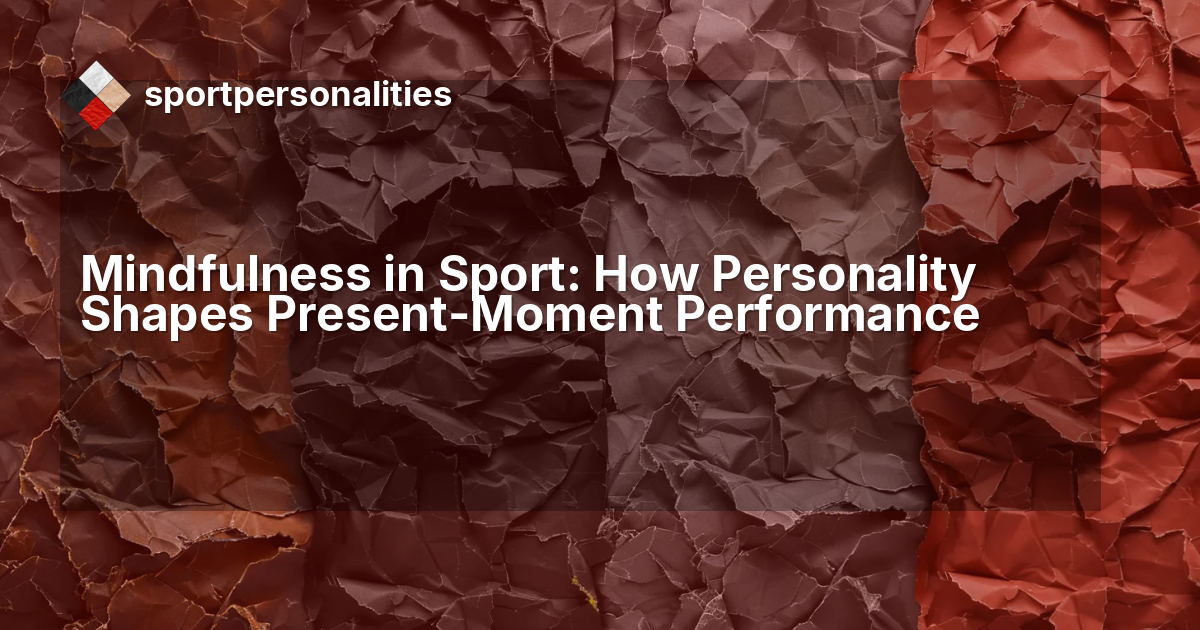Mindfulness for Athletes: Why Your Personality Determines How Presence Works
The arena falls silent. Seventy thousand spectators blur into background noise. The athlete's breath steadies, heart rate slows despite the pressure, and suddenly, despite the chaos, there exists only this moment, this play, this singular point of execution. This is what mindfulness looks like in athletic settings, and it might be the most underestimated performance tool in modern athletics.
Mindfulness isn't one-size-fits-all. The contemplative practice that centers one athlete might scatter another's focus entirely.
While sports culture traditionally glorified the grind, elite athletes across disciplines have discovered that the space between stimulus and response, that microsecond of conscious presence, often determines who wins and who wishes they had. Yet here's what is not generally talked about: mindfulness isn't one-size-fits-all. The contemplative practice that centers one athlete might scatter another's focus entirely.
Beyond the Breathing Exercise: What Mindfulness Actually Means for Athletes
Strip away the wellness industry packaging, and mindfulness becomes remarkably practical: the capacity to maintain deliberate attention on present-moment experience without judgment or reactivity. For athletes, this translates to executing under pressure without drowning in past mistakes or future consequences.
Neuroscience studies demonstrate that consistent mindfulness practice literally restructures the brain's attentional networks. The anterior cingulate cortex, responsible for conflict monitoring and error detection, shows increased activation and gray matter density in athletes who maintain regular mindfulness routines. In other words, these athletes' brains handle competitive stress in different ways.
However, this is where conventional sport psychology guidance fails. Most mindfulness protocols were developed for general populations, not for the unique psychological profiles that drive athletic excellence. Athletes who find their competitive drive in external validation will approach present-moment awareness in a different way than those who strive for internal mastery. Their nervous systems are wired toward different threat and reward signals.
The Role of Personality: Why Standard Mindfulness Protocols Miss the Mark
Consider two athletes preparing for the same championship final. One reviews the opponent's film obsessively, mapping contingency plans for every scenario. The other arrives with minimal preparation, trusting their ability to read and adapt in real time. Both are elite performers. Both could benefit from mindfulness. But prescribing identical contemplative practices would be like giving them the same training program regardless of their sport.
Athletes with reactive cognitive processing already live in the present moment instinctively, their challenge isn't achieving presence but channeling it strategically.
The SportPersonalities Four Pillars framework reveals why personality-matched mindfulness approaches consistently outperform generic protocols. These four psychological dimensions, how athletes process information, define success, source motivation, and relate to their environment, fundamentally shape how consciousness itself operates during competition.
Athletes with reactive cognitive processing already live in the present moment instinctively. Their challenge isn't achieving presence but channeling it strategically. Meanwhile, tactical thinkers must bridge the gap between their natural planning orientation and the demands of immediate execution. Neither approach is superior; they simply require different mindfulness architectures.
The Competitive Style Split
Self-referenced athletes measuring progress against personal standards need mindfulness techniques that deepen proprioceptive awareness and internal feedback loops. Body scanning practices and breath-focused meditation align naturally with their inward orientation. But other-referenced competitors defining success through opponent defeat often locate traditional seated meditation counterproductive, it dampens the competitive arousal that fuels their performance.
For these athletes, mindfulness becomes about maintaining tactical clarity while riding high arousal states. Their practices emphasize open monitoring, maintaining broad awareness of the competitive environment while executing their strategy without emotional reactivity to opponent actions.
Practical Application: Mindfulness Strategies Matched to Psychological Profile
 The Purist (ISTA) exemplifies how personality shapes mindfulness application. These autonomous, intrinsically motivated athletes pursuing tactical mastery already possess deep internal awareness. Their mindfulness work focuses on preventing overthinking from disrupting execution. Pre-competition protocols may include brief body scans to establish a foundation for systematic preparation in somatic presence, thereby facilitating a connection between analytical comprehension and seamless performance.
The Purist (ISTA) exemplifies how personality shapes mindfulness application. These autonomous, intrinsically motivated athletes pursuing tactical mastery already possess deep internal awareness. Their mindfulness work focuses on preventing overthinking from disrupting execution. Pre-competition protocols may include brief body scans to establish a foundation for systematic preparation in somatic presence, thereby facilitating a connection between analytical comprehension and seamless performance.
Contrast this with  The Superstar (EORC), collaborative, reactive athletes energized by competition and recognition. For them, mindfulness serves a different function entirely: maintaining performative presence amid the energetic chaos of team dynamics and opponent interaction. Their practices emphasize returning attention to immediate tactical opportunities rather than getting lost in the drama of rivalry or the intoxication of crowd energy.
The Superstar (EORC), collaborative, reactive athletes energized by competition and recognition. For them, mindfulness serves a different function entirely: maintaining performative presence amid the energetic chaos of team dynamics and opponent interaction. Their practices emphasize returning attention to immediate tactical opportunities rather than getting lost in the drama of rivalry or the intoxication of crowd energy.
 The Rival (EOTA) presents perhaps the most intriguing challenge. These tactical, other-referenced athletes thrive on strategic opponent analysis and external validation. Traditional mindfulness, with its emphasis on non-judgment and non-reactivity, seems antithetical to their competitive drive. Yet when properly adapted, present-moment awareness becomes their ultimate weapon: executing meticulously crafted game plans without being hijacked by the emotional satisfaction of dominating an opponent or the frustration when plans require adjustment.
The Rival (EOTA) presents perhaps the most intriguing challenge. These tactical, other-referenced athletes thrive on strategic opponent analysis and external validation. Traditional mindfulness, with its emphasis on non-judgment and non-reactivity, seems antithetical to their competitive drive. Yet when properly adapted, present-moment awareness becomes their ultimate weapon: executing meticulously crafted game plans without being hijacked by the emotional satisfaction of dominating an opponent or the frustration when plans require adjustment.
For  The Flow-Seeker (ISRA), mindfulness and sport become nearly indistinguishable. These intrinsically motivated, self-referenced athletes already pursue those transcendent states where self-consciousness dissolves into pure execution. Their development focuses on accessing flow states more reliably rather than achieving basic presence. Their practices might involve movement meditation, training sessions conducted with contemplative attention to sensation, breath, and the subtle feedback loops between intention and action.
The Flow-Seeker (ISRA), mindfulness and sport become nearly indistinguishable. These intrinsically motivated, self-referenced athletes already pursue those transcendent states where self-consciousness dissolves into pure execution. Their development focuses on accessing flow states more reliably rather than achieving basic presence. Their practices might involve movement meditation, training sessions conducted with contemplative attention to sensation, breath, and the subtle feedback loops between intention and action.
Different athletes face different mental barriers to presence. Before exploring how the Four Pillars shape performance, take this brief self-assessment to identify your focus blockers.
What’s Holding Back Your Focus?
Take the Mindfulness Barrier Detector to see which psychological patterns may be affecting your presence in competition.
The Four Pillars and Present-Moment Performance
According to research from SportPersonalities.com, the interaction between these psychological dimensions creates sixteen distinct athletic personalities, each requiring tailored approaches to mindfulness. Understanding where you fall within this framework transforms mindfulness from an abstract concept to a precision tool.
The Drive dimension, intrinsic versus extrinsic motivation, significantly affects athletes' relationship with mindfulness practice. Intrinsically motivated athletes often embrace contemplative work naturally, finding the process inherently satisfying. But extrinsically driven competitors may need to frame mindfulness through performance outcomes: reduced anxiety, improved decision-making, and faster recovery between competitive efforts.
The Social Style dimension reveals another crucial distinction. Collaborative athletes might develop mindfulness capacity most effectively through group practices, team meditation sessions or shared breathing exercises that leverage their natural synchronization with others. Autonomous athletes typically prefer solo practices where they can explore internal experience without the distraction of group dynamics.
Building Your Mindfulness Architecture: Beyond Cookie-Cutter Protocols
The practical question becomes: how do you construct a mindfulness practice that enhances rather than conflicts with your natural psychological wiring?
Start with honest self-assessment across the Four Pillars. Do you process competition through systematic analysis or intuitive adaptation? Do you measure success against your own standards or through defeating opponents? Does motivation come from the activity itself or from external recognition? Do you prefer training autonomy or collaborative energy?
Find Your Sport Personality
Take the free SportDNA Assessment to uncover which of the 16 athletic profiles best matches your motivation, mindset, and competitive style.
Start NowThe personality type and traits you display should be your first guide. A tactical, self-referenced athlete might build mindfulness capacity through detailed body scanning, systematically moving attention through muscle groups, cataloging sensation, and developing the refined proprioceptive awareness that supports technical precision. This practice aligns with their natural cognitive style while deepening the internal reference points that guide their competitive journey.
Meanwhile, a reactive, other-referenced athlete benefits more from open monitoring practices, maintaining broad awareness of the competitive field without fixating on any single element. This helps them naturally notice and react to new patterns while stopping their emotions from interfering with their tactical performance.
How to Integrate Mindfulness: When Mindfulness Meets Competition Reality
Theory collapses without addressing the practical obstacles that derail even well-designed mental training programs. The most common failure point? The most common failure point is the attempt to maintain contemplative presence during crucial moments when competitive arousal peaks.
The solution isn't suppressing arousal, mindfulness becomes about maintaining executive function while riding high arousal states, not dampening competitive fire.
The solution isn't suppressing arousal, that intensity often fuels peak performance. Instead, mindfulness becomes about maintaining executive function while riding high arousal states. Brief practices integrated throughout competition day prove more effective than lengthy pre-event sessions. Thirty seconds of deliberate breathing between points, plays, or attempts keeps the attentional system calibrated without dampening competitive fire.
Another challenge emerges for athletes whose personalities incline toward rumination. Tactical thinkers analyzing past mistakes or self-referenced athletes scrutinizing technical details can spiral into performance-degrading overthinking. For them, mindfulness practices emphasize redirecting attention to immediate sensory experience, the feel of equipment, the sound of breath, the sensation of movement, using somatic anchors to escape mental loops.
 The Maverick (IORA) and
The Maverick (IORA) and  The Gladiator (EORA) sport profiles, autonomous, reactive athletes driven by defeating opponents, face a unique integration challenge. Their spontaneous brilliance and competitive intensity seem at odds with the deliberate cultivation mindfulness requires. Yet when framed correctly, present-moment awareness becomes the ultimate competitive weapon: executing with complete commitment while maintaining the mental flexibility to adapt when their spontaneous approach encounters unexpected resistance.
The Gladiator (EORA) sport profiles, autonomous, reactive athletes driven by defeating opponents, face a unique integration challenge. Their spontaneous brilliance and competitive intensity seem at odds with the deliberate cultivation mindfulness requires. Yet when framed correctly, present-moment awareness becomes the ultimate competitive weapon: executing with complete commitment while maintaining the mental flexibility to adapt when their spontaneous approach encounters unexpected resistance.
Advanced Applications: Mindfulness as Competitive Intelligence
Elite implementation goes beyond stress management to become a more advanced form of competitive awareness. Athletes who master present-moment attention develop the capacity to simultaneously execute their own strategy while processing opponent patterns and environmental variables in real time.
This multilayered awareness is especially helpful for athletes who play sports that are fast-paced and involve a lot of interaction. A point guard maintaining mindful presence can track defensive rotations, read teammate positioning, and execute complex plays without conscious deliberation, their attention distributed across multiple information streams while remaining anchored in immediate execution.
Research demonstrates that mindfulness training enhances interoceptive awareness, the ability to accurately perceive internal bodily states. Athletes develop refined sensitivity to fatigue, arousal levels, and the subtle physiological signals preceding optimal performance states. This internal intelligence informs strategic decisions: when to push harder, when to conserve, and when conditions align for maximum-effort execution.
The Competitive Advantage: Why Personality-Matched Mindfulness Wins
Generic sport psychology advice treats athletes as interchangeable units requiring identical mental training. This approach produces mediocre results because it ignores the fundamental psychological diversity that creates different paths to excellence.
The SportPersonalities framework provides what competitors lack: a systematic method for matching mental training approaches to individual psychological architecture. An athlete who understands their cognitive style, competitive orientation, motivational drivers, and social preferences can construct mindfulness practices that enhance rather than conflict with their natural wiring.
Personalized mindfulness gives athletes a clear edge. When mental routines match an athlete’s natural motivation, attention style, and competitive mindset, the results compound over time. Skill acquisition becomes smoother, performance steadier, and access to peak states more consistent. These athletes also tend to sustain their routines longer because the methods feel intuitive rather than forced.
Mindfulness works best when it reflects the individual’s psychology under pressure. Athletes who build practices around their own focus patterns develop the kind of attentional control that translates directly into performance. Instead of generic breathing drills and visualization scripts, they use tools designed for how they actually think and compete. That precision is what turns mental training into a competitive advantage.
References
- A meta-analysis of the intervention effect of mindfulness training on athletes’ performance (Pmc.ncbi.nlm.nih.gov)
- Mindfulness and mental wellbeing among elite athletes: The mediating role of gratitude and self-compassion (Sciencedirect.com)
- Mindfulness techniques for athletic excellence: the mediating role of mental resilience and moderating effect of emotional intelligence (Frontiersin.org)
- The relationship between mindfulness and athletes’ mental skills may be explained by emotion regulation and self-regulation (Pmc.ncbi.nlm.nih.gov)
- The effects of psychological skills and mindfulness on well-being of student-athletes: A path analysis (Sciencedirect.com)
This content is for educational purposes, drawing on sport psychology research and professional experience. I hold an M.A. in Social Psychology, an ISSA Elite Trainer and Nutrition certification, and completed professional training in Sport Psychology for Athlete Development through the Barcelona Innovation Hub. I am not a licensed clinical psychologist or medical doctor. Individual results may vary. For clinical or medical concerns, please consult a licensed healthcare professional.







